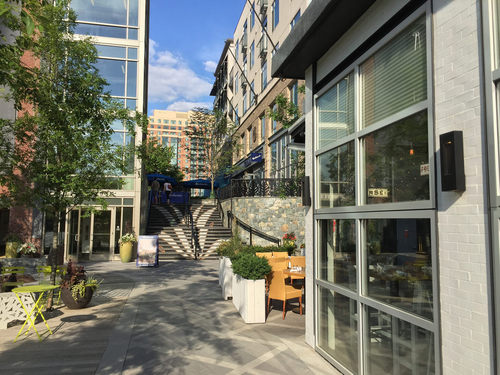The dilemma for young people in Montgomery County
你”re a Millennial working in Montgomery County. You want to be close to work, but you also want to be close to the action. Can you find both here? Sort of.

If you’re a Millennial in Montgomery County, you might want to live in North Bethesda. Photo by the author.
That’s something county leaders have been working on. Three years ago, Montgomery County began its Night Time Economy Initiative to bring in businesses by attracting the Millennial (or young adults born between 1982 and 2000) they wish to employ. Noting studies saying Millennials want to live in urban (or urban-lite) settings, the county has been redeveloping its town centers, building bike lanes, and revising liquor laws.
While the nation’s largest generation isn’t a monolith, there’s some truth to the narrative. The county’s young professionalstend to live near its job centers, transit lines, and favored hangouts. That generally means Silver Spring, Bethesda, and Rockville.
That said, for those who want the urban experience, the county has serious competition from other parts of the region, especially the District and Arlington. And if you work in Montgomery County, particularly outside the Beltway, you’re forced to choose living in an urban neighborhood far from work or a more suburban area with a shorter commute.
I was thinking about that reading this recent email from天空, a young teacher moving to Montgomery County and wondering where a Millennial should live.
Hello Dan (or Co.),
I recently read an article about millennials in Moco and am wondering if you would give me some advice about where to live.
I will probably be moving to the area to teach [in Gaithersburg] and would love to know where young singles live around the area.
Like your article said, I certainly want to be close to work, but I also want to have a thriving personal life.
If you have any suggestions, the would be much appreciated.
Thank you!
Awesome blog btw!
这是我如何回答说:
谢谢你写我的言语!你”ve presented an interesting challenge: you work in Gaithersburg, but you want to be near the action. Those two things are (mostly) mutually exclusive, as much of the region’s nightlife is in DC, 20 miles away. That said, this isn’t an impossible situation. Of the 20- and 30-somethings I know who work in Montgomery County, they generally do one of three things:
- Live in DC, and do the reverse commute.你”ll have your pick of hoppin neighborhoods with lots of things to do and people to meet, and you won’t have to drive home after the bar. You will, however, have to drive to work, though you’ll mostly be going against traffic on your way out of the city. Consider neighborhoods like Columbia Heights, Dupont Circle, and Adams Morgan, which are both filled with young people and things to do, but also near major roads like 16th Street and Connecticut Avenue that you can use to get out of the city. This might be the most expensive option, since you’d be paying higher DC rents and paying for the cost of transportation.
- Live in Gaithersburg.你”ll be really close to school, and while Gaithersburg is a lot quieter than DC, there are a couple of areas with restaurants and bars. Kentlands is a nationally-famous neighborhood where you can walk to shops and restaurants. Old Town Gaithersburg has a growing number of Latino and African restaurants that are pretty great. And Rio/Washingtonian Center has a lakefront that’s great for hanging out on weekends. The rents are generally cheaper than DC, though transit service is limited (there’s no Metro station) so you will be driving a fair amount.
- Live somewhere in the middle.The Red Line connects Montgomery County to DC and the rest of the region, and stops in several walkable neighborhoods in Montgomery County with lots of things to do and a large number of young people. You’ll still get that reverse commute, though you’ll pay a premium to live next to a Metro station. Three areas you might want to consider: Bethesda’s more expensive, but has lots of places to hang out; Silver Spring (where I live) is more affordable, way younger, also has lots going on, and is closest to DC; Rockville is also more affordable and closer to Gaithersburg, but has less nightlife.
A few weeks ago, Sky let me know that she’s moving to Rockville, which offers the best of both worlds: it’s close to work, but also has a real downtown and access to the Metro.
For years, Montgomery County has encouraged the creation of more downtowns and town centers in places like White Flint, Germantown, and White Oak, while promoting the ongoing development of urban places like Silver Spring or Bethesda. That’s great for people moving to the area like Sky, because it gives her more, and more affordable, choices for where to live. However, we still have lots of work to do in making these places attractive to new, younger residents, from creating more walkable and bikeable streets to streamlining our liquor laws to make it easier for restaurants and bars to open here.
We’ll have to follow up with Sky once she gets settled in. But in the meantime: What would you tell a young person interested in moving to the county?
